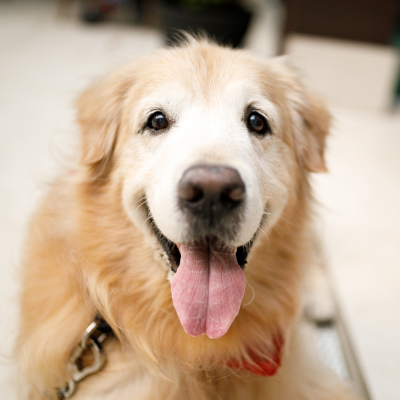Lost pet prevention isn’t a one and done sort of thing. It’s important to remember all of the tools in your toolbox throughout your dog’s entire life, because something that works for him as a puppy might not work for him as he ages into a dog who’s retired from dog park playdates.
But no need to worry! We sat down with Robin Bennett, one of the leading dog training experts and co-founder of The Dog Gurus. Keep on reading for tips on how to keep your dog at home throughout his entire life.
.jpg?RwD5SdDxH1XpmJw.jpB0x25zzawukWWE)
Life-Long Safety Measures
Pet Identification
Pet identification is one of the more obvious lost pet prevention tools for a pet parent, Bennett says. Remember to use multiple types of pet identification for your pup, including: external ID tags (consider PetHub’s digital ID tag), registered microchips, pet license, and all the other types of identification tools.
Training
Bennett explains that training is the best tool for raising a dog that not only understands cues to come back to you, but listens.
“Most pet parents are pretty good at teaching their dog the come command on a very limited scale, but what they don’t understand is that dogs don’t generalize very well,” Bennett adds. “So having your dog come in the house is one thing, but doing it outside, are you sure he will still come?”
Trainers define it as the “3 D’s of Training”: distance, distraction, and duration. Come up with a strategy to teach your dog to come in a wide range of locations, from a wide range of distances, around a wide range of distractions, Bennett adds. And it takes time.

“What we tend to do - as humans - is teach the very basic. We teach come and we think the dog will come back from anywhere, no matter what the situation is,” she says. “And that’s just not realistic.”
Simple Management
What Bennett means here is to not take the risk of being someplace with your dog where he can get lost (whether it’s in your backyard or on a walk). No, that doesn’t mean your dog can never go outside; what it means is be aware of your surroundings. Is the area fenced in? If not, make sure your dog is on a leash.
“While my dog isn’t prone to running away, our gate was prone to blowing open in the wind,” Bennett explains. “So we put measures in place to make sure that our dog was safely enclosed in the yard. We put a carabiner on the gate and got in the habit of checking to make sure it was sturdy.”
Understand Your Dog’s Fears
People often underestimate the panic that a dog goes through that can cause them to run away, Bennett says.
“The dog isn’t trying to get away from the family, but they are in panic mode,” she adds. “Understanding your dog’s temperament and knowing what he is afraid of will allow you to help him by creating secure environments.”
Learning to recognize when your dog is showing signs of stress can be super helpful. When this happens pet parents need to help their dog and not push them aside, Bennett says.
“Dogs will start to panic more when the one person in their life that they are bonded with doesn’t do anything to help them,” she adds. Your dog is going to take matters into his own paws and sometimes that means trying to get out the backdoor or breaking through the window.
Considerations for a Puppy
Transitioning From Timid To Wanderer
For the first several months of a dog’s life, he’ll probably stay close to you while exploring the outdoors. Once your pup reaches 5 months, he will be much more interested in roaming further away from home.
“Typically, what I see as a dog trainer is that between 8 weeks old to 16 weeks old the pup won’t wander very far away and people will not use a leash or any kind of safety measures because the puppy comes back when they call him” Bennett says. “But after 16 weeks that starts to not work. People then call me saying that their dog won’t come anymore; in reality, the dog never actually learned how to come because they were never taught. He was just too young and insecure to wander too far away.”
This can cause a false sense of security for new pet parents, she adds. This can lead to a high probability of the puppy running away because as a pet parent you’re caught off guard when he doesn’t come like he used to.
The wanderer phase of a dog’s life can last for several years which is why it is even more important to regularly train your dog. The Dog Gurus have a great online puppy training course!

Bad Experiences As A Puppy Stick Around
It is completely normal to want to take your new puppy with you everywhere. However it’s important to remember that you have no idea how that puppy is going to react to any given situation. If he reacts poorly, most likely a fear or phobia will be formed around similar situations.
“This is especially true for puppies who are younger than 4 months old,” Bennett adds. She recommends introducing your puppy to new experiences in a way that is safe for the pup. Be sure to consider what a busy dog park could be like for a young puppy who still hasn’t met a lot of people and other dogs.
Considerations for an Adult Dog
The Active And Roaming Dog
Dogs become more bold as they mature and enter into their adult years. They are more active and willing to roam farther from home when they are curious, or even when they are scared.
“Luckily by then you’ve seen (if you’ve had your dog for several years) what he is afraid of and what triggers anxiety or other signs of discomfort,” Bennett says. “It is your job to help your dog manage those triggers, fears, and reactions.”
Don’t Forget Your Basics
Remember how we talked about identification earlier? Yup, we’re repeating it because it is that important. Make sure your dog is always wearing a secure collar with an external ID tag (ideally connected to multiple phone numbers). If you adopted your pup, he is mostly microchipped. Do you remember if you registered his chip? Have you moved since you got him? It’s a good idea to check with the microchip company; don’t worry if you can’t remember what brand his microchip is -- most veterinary clinics and animal shelters have microchip scanners and they can help you determine what information if available on his chip.
Michelson Found Animals has a free microchip registry where you can register your pet’s microchip number (they accept all brands and all frequencies).
Considerations for a Senior Dog
Sensitivity Comes With Age
Senior dogs can become more sound sensitive as they grow older. Even dogs who never reacted poorly to loud noises can grow fears and phobias later in life, Bennett adds.
“You need to be mindful of that,” she says. “A lot of older dogs get panicked faster, and there are new studies showing that dogs can develop a form of canine dementia. This can lead to your dog easily wandering off, getting scared, and becoming lost. So you just need to make sure you are taking precautions to make sure that doesn’t happen.”

Old, Wise Bones
Just like people, as dogs get older they become more frail. If your older dog does go missing it tends to be a more critical situation because they might need medication or they might get injured more quickly than a younger dog, Bennett says.
PetHub tags can help you keep track of all of your dog's needs, including medications, injuries, and any other important information someone would need to know if they found your dog.
One Last Piece Of Advice
If Your Dog Does Go Missing
When you go looking for your dog, it is important to understand that he might be in the state of shock, Bennett says.
“We all have this vision that we will see our dog and he will come running back to us,” she adds. “But a lot of times - especially if the dog is lost for more than a day - they get into a state of shock where they don’t necessarily come running back because they are really scared.”
So remember to take a lot of his favorite treats, be patient, and don’t rush him even though he is your dog.
Robin Bennett is one of the leading experts on dog training. As a Certified Professional Dog trainer, she has over 20 years of experience in the dog training world and founded one of the largest dog training companies in Virginia. She is currently one of the co-founders of The Dog Gurus and has been using her expertise in “reading dogs” to teach families how to train their pets as well as helping others in the pet care industry keep dogs safe.


